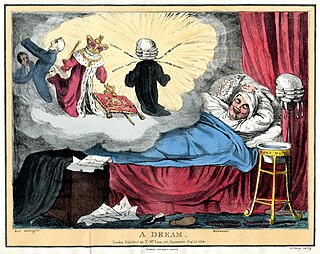Related Research Articles

Consciousness, at its simplest, is awareness of internal and external existence. However, its nature has led to millennia of analyses, explanations and debate by philosophers, theologians, and all of science. Opinions differ about what exactly needs to be studied or even considered consciousness. In some explanations, it is synonymous with the mind, and at other times, an aspect of mind. In the past, it was one's "inner life", the world of introspection, of private thought, imagination and volition. Today, it often includes any kind of cognition, experience, feeling or perception. It may be awareness, awareness of awareness, or self-awareness either continuously changing or not. The disparate range of research, notions and speculations raises a curiosity about whether the right questions are being asked.

A dream is a succession of images, ideas, emotions, and sensations that usually occur involuntarily in the mind during certain stages of sleep. Humans spend about two hours dreaming per night, and each dream lasts around 5 to 20 minutes, although the dreamer may perceive the dream as being much longer than this.

Consciousness Explained is a 1991 book by the American philosopher Daniel Dennett, in which the author offers an account of how consciousness arises from interaction of physical and cognitive processes in the brain. Dennett describes consciousness as an account of the various calculations occurring in the brain at close to the same time. He compares consciousness to an academic paper that is being developed or edited in the hands of multiple people at one time, the "multiple drafts" theory of consciousness. In this analogy, "the paper" exists even though there is no single, unified paper. When people report on their inner experiences, Dennett considers their reports to be more like theorizing than like describing. These reports may be informative, he says, but a psychologist is not to take them at face value. Dennett describes several phenomena that show that perception is more limited and less reliable than we perceive it to be.

Mind uploading is a speculative process of whole brain emulation in which a brain scan is used to completely emulate the mental state of the individual in a digital computer. The computer would then run a simulation of the brain's information processing, such that it would respond in essentially the same way as the original brain and experience having a sentient conscious mind.
Computational neuroscience is a branch of neuroscience which employs mathematics, computer science, theoretical analysis and abstractions of the brain to understand the principles that govern the development, structure, physiology and cognitive abilities of the nervous system.
In the philosophy of mind, panpsychism is the view that the mind or a mind-like aspect is a fundamental and ubiquitous feature of reality. It is also described as a theory that "the mind is a fundamental feature of the world which exists throughout the universe". It is one of the oldest philosophical theories, and has been ascribed to philosophers including Thales, Plato, Spinoza, Leibniz, William James, Alfred North Whitehead, Bertrand Russell, and Galen Strawson. In the 19th century, panpsychism was the default philosophy of mind in Western thought, but it saw a decline in the mid-20th century with the rise of logical positivism. Recent interest in the hard problem of consciousness and developments in the fields of neuroscience, psychology, and quantum physics have revived interest in panpsychism in the 21st century.

In philosophy of mind, the hard problem of consciousness is to explain why and how humans and other organisms have qualia, phenomenal consciousness, or subjective experiences. It is contrasted with the "easy problems" of explaining why and how physical systems give a (healthy) human being the ability to discriminate, to integrate information, and to perform behavioral functions such as watching, listening, speaking, and so forth. The easy problems are amenable to functional explanation—that is, explanations that are mechanistic or behavioral—since each physical system can be explained purely by reference to the "structure and dynamics" that underpin the phenomenon.
Non-rapid eye movement sleep (NREM), also known as quiescent sleep, is, collectively, sleep stages 1–3, previously known as stages 1–4. Rapid eye movement sleep (REM) is not included. There are distinct electroencephalographic and other characteristics seen in each stage. Unlike REM sleep, there is usually little or no eye movement during these stages. Dreaming occurs during both sleep states, and muscles are not paralyzed as in REM sleep. People who do not go through the sleeping stages properly get stuck in NREM sleep, and because muscles are not paralyzed a person may be able to sleepwalk. According to studies, the mental activity that takes place during NREM sleep is believed to be thought-like, whereas REM sleep includes hallucinatory and bizarre content. NREM sleep is characteristic of dreamer-initiated friendliness, compared to REM sleep where it is more aggressive, implying that NREM is in charge of simulating friendly interactions. The mental activity that occurs in NREM and REM sleep is a result of two different mind generators, which also explains the difference in mental activity. In addition, there is a parasympathetic dominance during NREM. The reported differences between the REM and NREM activity are believed to arise from differences in the memory stages that occur during the two types of sleep.
The consciousness and binding problem is the problem of how objects, background and abstract or emotional features are combined into a single experience.

Animal consciousness, or animal awareness, is the quality or state of self-awareness within an animal, or of being aware of an external object or something within itself. In humans, consciousness has been defined as: sentience, awareness, subjectivity, qualia, the ability to experience or to feel, wakefulness, having a sense of selfhood, and the executive control system of the mind. Despite the difficulty in definition, many philosophers believe there is a broadly shared underlying intuition about what consciousness is.

Giulio Tononi is a neuroscientist and psychiatrist who holds the David P. White Chair in Sleep Medicine, as well as a Distinguished Chair in Consciousness Science, at the University of Wisconsin. He is best known for his Integrated Information Theory (IIT), a mathematical theory of consciousness, which he has proposed since 2004.

The neural correlates of consciousness (NCC) are the minimal set of neuronal events and mechanisms sufficient for the occurrence of the mental states to which they are related. Neuroscientists use empirical approaches to discover neural correlates of subjective phenomena; that is, neural changes which necessarily and regularly correlate with a specific experience. The set should be minimal because, under the materialist assumption that the brain is sufficient to give rise to any given conscious experience, the question is which of its components are necessary to produce it.

Homeostatic feeling is a class of feelings that inform us about our physiological condition. In his earlier work Antonio Damasio used "primordial feeling" but he now prefers the term "homeostatic feeling" for the class.

Integrated information theory (IIT) proposes a mathematical model for the consciousness of a system. It comprises a framework ultimately intended to explain why some physical systems are conscious, and to be capable of providing a concrete inference about whether any physical system is conscious, to what degree, and what particular experience it is having; why they feel the particular way they do in particular states, and what it would take for other physical systems to be conscious.
Reentry is a neural structuring of the brain, which is characterized by the ongoing bidirectional exchange of signals along reciprocal axonal fibers linking two or more brain areas. It is hypothesized to allow for widely distributed groups of neurons to achieve integrated and synchronized firing, which is proposed to be a requirement for consciousness, as outlined by Gerald Edelman and Giulio Tononi in their book A Universe of Consciousness.
Karl John Friston FRS FMedSci FRSB is a British neuroscientist and theoretician at University College London. He is an authority on brain imaging and theoretical neuroscience, especially the use of physics-inspired statistical methods to model neuroimaging data and other random dynamical systems. Friston is a key architect of the free energy principle and active inference. In imaging neuroscience he is best known for statistical parametric mapping and dynamic causal modelling. In October 2022, he joined VERSES Inc, a California-based cognitive computing company focusing on artificial intelligence designed using the principles of active inference, as Chief Scientist.

Consciousness after death is a common theme in society and culture, and the belief in some form of life after death is a feature of many religions. However, scientific research has established that the physiological functioning of the brain, the cessation of which defines brain death, is closely connected to mental states.
Eternal oblivion is the philosophical, religious, or scientific concept of one's consciousness forever ceasing upon death. Pamela Health and Jon Klimo write that this concept is mostly associated with religious skepticism, secular humanism, nihilism, agnosticism, and atheism. According to most modern neuroscience theories of consciousness, the brain is the basis of subjective experience, agency, self-awareness, and awareness of the surrounding natural world. When brain death occurs, all brain function forever ceases.

Being You: A New Science of Consciousness is a 2021 non-fiction book by neuroscientist Anil Seth, published by Faber and Faber. The book explores the author's theory of consciousness and the self. Seth also looks at the relationship between humans, animals, and the potential for machines to have consciousness.
References
- ↑ "New Math Untangles the Mysterious Nature of Causality". Wired. ISSN 1059-1028 . Retrieved May 19, 2021.
- ↑ Horgan, John. "Second Thoughts on Whether Self-Knowledge Is Overrated". Scientific American Blog Network. Retrieved May 19, 2021.
- ↑ "A Theory of Reality as More Than the Sum of Its Parts". Quanta Magazine. June 1, 2017. Retrieved May 19, 2021.
- 1 2 "New Math Untangles the Mysterious Nature of Causality". Wired. ISSN 1059-1028 . Retrieved May 21, 2021.
- 1 2 "Weird dreams train us for the unexpected, says new theory". the Guardian. May 14, 2021. Retrieved May 21, 2021.
- ↑ "Weird Dreams Keep Our Brains Fit, Help Humans Cope Better with Reality, Finds Study". www.news18.com. May 19, 2021. Retrieved May 21, 2021.
- ↑ "Erik Hoel". Forbes. Retrieved May 19, 2021.
- ↑ "Can we locate cause and effect in the brain?". giving.columbia.edu. Retrieved June 23, 2021.
- ↑ "Erik Hoel – Scholars | Institute for Advanced Study". www.ias.edu. December 9, 2019. Retrieved June 23, 2021.
- ↑ Musser, George (May 4, 2017). "A Theory of Consciousness Can Help Build a Theory of Everything". Nautilus. Retrieved June 23, 2021.
- 1 2 Correspondent, James Sullivan Globe; June 28, Updated. "Jabberwocky Books hatches a new novelist: the owner's son – The Boston Globe". BostonGlobe.com. Retrieved May 10, 2022.
{{cite web}}: CS1 maint: numeric names: authors list (link)(subscription required) - ↑ Hoel, Erik P. (October 21, 2015). "'City on Fire': Will Television Ruin Fiction?". The Atlantic. Retrieved June 23, 2021.
- ↑ "Enter the Supersensorium | Erik Hoel". The Baffler. May 4, 2019. Retrieved June 23, 2021.
- ↑ "Is there a scientific case for literature? A neuroscientist novelist argues yes". Salon. April 18, 2021. Retrieved June 23, 2021.
- ↑ "Bookish: Mixing Science and Fiction in a Literary Novel". Tufts Now. June 8, 2021. Retrieved June 23, 2021.
- ↑ "Fiction Book Review: The Revelations by Erik Hoel. Overlook, $27 (368p) ISBN 978-1-4197-5022-9". PublishersWeekly.com. November 2020. Retrieved June 23, 2021.
- ↑ "Science". ERIK HOEL. Retrieved May 10, 2022.